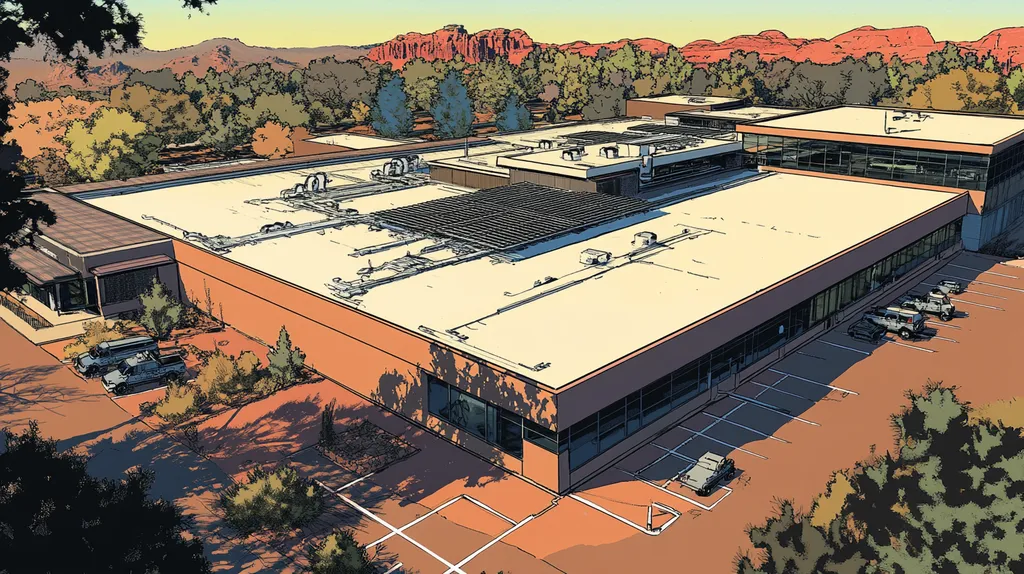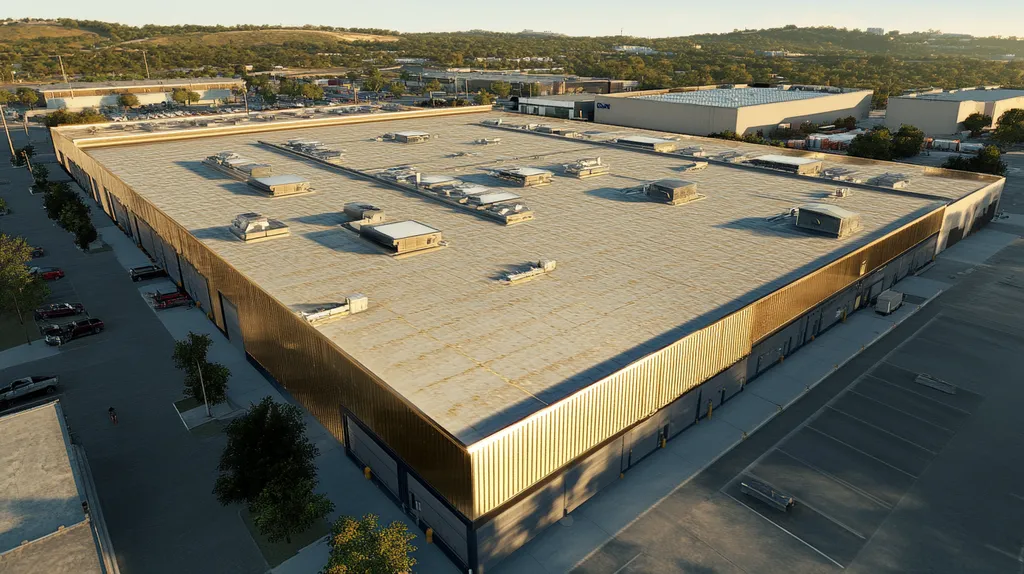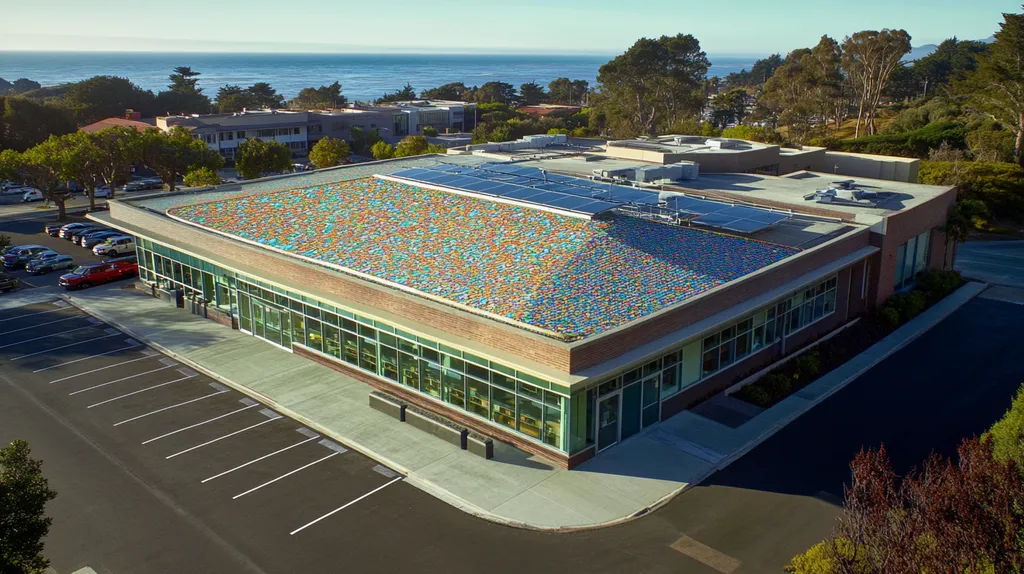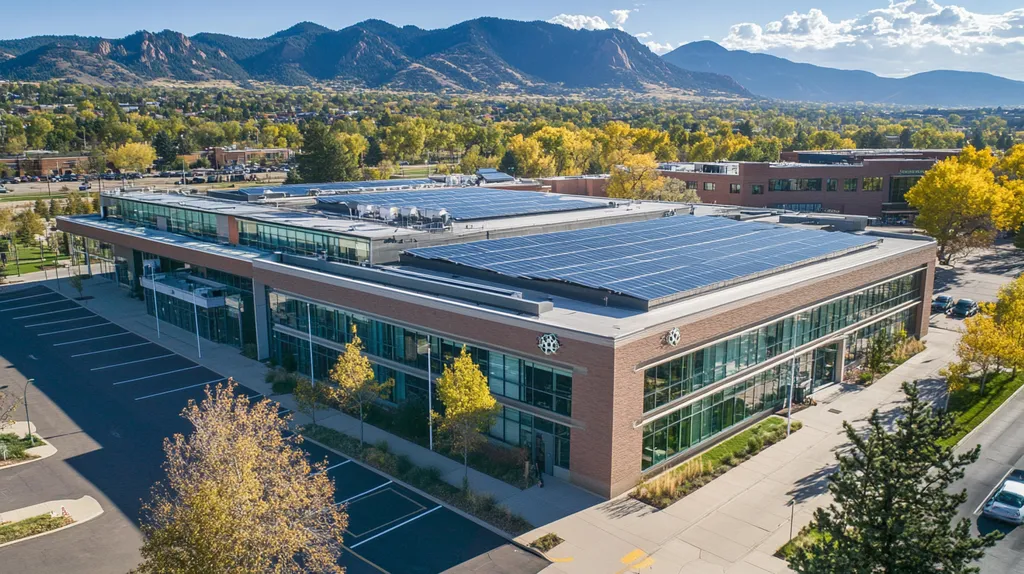Water damage from poor roof drainage costs commercial property owners over $3.7 billion annually in repairs, with 80% of all roof failures linked to drainage issues. Modern monitoring technologies now offer unprecedented capabilities to detect and prevent these catastrophic failures.
From wireless sensors to predictive analytics, innovative drainage monitoring systems are transforming how facilities protect their roofing investments. Understanding these technologies is crucial for property owners and facility managers seeking to safeguard their buildings.
This comprehensive guide examines the essential components, implementation strategies, and maintenance requirements of commercial roof drainage monitoring systems, providing actionable insights for optimal performance.
SECTION 1: FUNDAMENTAL CONCEPTS
Ensuring effective roof drainage is vital for safeguarding the integrity of commercial and industrial properties. Poor drainage can lead to serious issues like water pooling, which may result in structural damage, mold growth, and outrageous repair expenses. Alarmingly, almost 80% of commercial roof failures are linked to inadequate drainage, according to the National Roofing Contractors Association (NRCA). For property owners and facility managers, grasping the basic concepts of roof drainage systems is essential for reducing risks and securing long-lasting performance.
Principles of Roof Drainage
The main role of roof drainage systems is to effectively channel water away from the roof’s surface. Failing to manage water properly can result in leaks and deterioration of structural elements. These systems rely on gravity to guide water toward designated exit points, which alleviates stress on the roof membrane.
Key principles include maintaining an appropriate slope, strategically placing drainage components, and ensuring the system can handle sudden rain events. Ideally, roofs should have a slope of at least 1% to promote efficient drainage. Routine inspections are essential to verify that these principles are consistently applied.
Incorporating cutting-edge drainage technologies can significantly improve system efficiency. Innovative solutions now feature sensors and automated mechanisms that monitor water levels in real-time. This proactive approach empowers facility managers to resolve drainage concerns before they evolve into expensive problems.
Understanding these fundamental principles equips anyone responsible for commercial roofing with the knowledge needed to champion effective drainage solutions and prioritize ongoing maintenance strategies.
Types of Drainage Systems
There are various types of drainage systems utilized in commercial roofing, each offering unique benefits suited to different building designs and weather conditions. Common types include internal drains, scuppers, roof drains, and downspouts.
Internal drains are often found in flat-roofed structures and direct water through the roof into the building’s plumbing system. Scuppers, typically installed at the roof’s edge, enable water to flow off the roof without relying on internal systems, making them particularly effective in regions with heavy rainfall.
Combining roof drains with downspouts helps manage rooftop runoff efficiently. These systems can also be integrated with green roofs, which utilize vegetation to absorb water while providing enhanced insulation.
Choosing the right type of drainage system depends on several factors, including local climate conditions, building structure, and roofing materials. Each system requires specific maintenance for optimal performance, underscoring the importance of regular evaluations and potential upgrades.
Importance of Leak Detection
Leak detection is an indispensable aspect of effective roof maintenance. Undetected leaks can lead to significant damage to both the building’s structure and its interior. Implementing early leak detection strategies not only conserves financial resources but also safeguards against potential liabilities.
Advancements in leak detection technology have been remarkable. Modern systems now use moisture sensors and thermal imaging to pinpoint concealed leaks before they escalate into major challenges. This proactive monitoring can drastically minimize the risk of extensive water damage.
Regular inspections are essential when combined with these advanced technologies. Experienced professionals can spot vulnerabilities in the roofing system, enabling prompt resolutions. This includes thoroughly checking seams, flashings, and drainage points for signs of wear or blockages.
In the end, a robust leak detection regimen allows property owners and facility managers to effectively mitigate risks. By investing in monitoring and maintenance, they not only protect their investments but also ensure the longevity of their roofing systems. Continuous, automated leak detection technologies can monitor roof membrane performance in real-time, identifying breaches more rapidly and accurately than traditional methods (source: Waterproof Magazine).
SECTION 2: SYSTEM COMPONENTS
Effective monitoring of commercial roof drainage is essential to prevent costly water damage and structural issues. With up to 80% of roof-related problems stemming from poor drainage, leveraging advanced technologies can significantly reduce these risks. This section delves into key components such as wireless monitoring devices, central gateways, and innovative sensors that optimize drainage management efficiently.
Wireless Monitoring Devices
Wireless monitoring devices are a cornerstone of modern roof drainage systems. These cutting-edge tools can track water levels, detect blockages, and send real-time alerts directly to facility managers. By utilizing Internet of Things (IoT) technology, they ensure seamless communication without the hassle of extensive wiring.
For instance, a property equipped with wireless sensors can gather valuable data on drainage efficiency across different weather conditions. This information can inform maintenance schedules and help predict potential drainage failures. By regularly monitoring the system, the risk of sudden leaks or overflows is minimized, safeguarding valuable assets.
Moreover, many of these devices feature user-friendly interfaces that enable property owners to access live data from their smartphones or computers. Such accessibility ensures that decision-makers can respond quickly in emergencies, potentially saving both time and money on repairs.
By adopting wireless technology, property managers can maintain continuous oversight of their roofs, which extends the lifespan of roofing materials and reduces repair costs.
Central Gateways and Hubs
Central gateways and hubs act as the command center for a roof drainage monitoring system. They compile data from various wireless devices, providing a centralized location for analysis and ensuring that all information is processed efficiently and relayed to the appropriate personnel.
These hubs can easily integrate with existing building management systems, streamlining operations and giving facility managers a comprehensive view of critical data in one convenient place. This consolidation minimizes confusion and enhances their ability to make informed decisions.
Advanced central gateways may also employ machine learning algorithms to anticipate maintenance needs based on usage patterns. For example, a hub could analyze rainfall data and historical drainage performance, predicting when issues may arise and prompting timely interventions.
Establishing a centralized data collection point not only boosts efficiency but also empowers property owners to allocate budgets effectively for future roofing investments. Solid data lays the foundation for smarter planning and resource management.
Sensor and Detector Technologies
Sensor and detector technologies are vital for gaining comprehensive insights into roof drainage systems. These devices monitor critical parameters like moisture levels and temperature, offering a complete picture of roof performance. Early detection of water accumulation is crucial for preventing significant damage and preserving the structure’s integrity.
For example, moisture sensors can pinpoint areas prone to leaks. When coupled with automatic alerts, these sensors enable property managers to address emerging issues swiftly. This proactive approach significantly reduces the risk of extensive water damage.
Moreover, advanced sensor technologies can integrate with predictive analytics platforms. This collaboration aids in forecasting long-term structural health, allowing owners to make well-informed decisions regarding necessary repairs or replacements.
By investing in these technologies, businesses not only protect their properties but also contribute to sustainability efforts. Enhanced drainage systems reduce water waste, leading to lower operational costs and a smaller environmental footprint, aligning with contemporary corporate responsibilities.
SECTION 3: IMPLEMENTATION METHODS
Implementing effective monitoring systems for commercial roof drainage is crucial in preventing water damage and maintaining building integrity. With more than 50% of commercial roof failures linked to inadequate drainage, the need for proactive measures is apparent. Property owners and facility managers must prioritize these systems to mitigate risks and extend the lifespan of their roofs. This section will cover the installation of monitoring systems, integration with building management systems, and grid-based leak detection setups.
Installation of Monitoring Systems
Installing roof drainage monitoring systems is vital for the early detection of water accumulation. By strategically placing sensors throughout the roof, management can receive alerts at the first sign of potential issues. These systems typically incorporate rain gauges and water level sensors, providing real-time data about drainage effectiveness.
Modern monitoring systems enhance responsiveness by sending instant notifications directly to property managers. This proactive notification system empowers teams to take immediate action, significantly reducing the likelihood of leaks and consequential damage. Effective implementation of these systems can be a game changer in prolonging roof life.
Cost-effectiveness is another compelling reason for installing monitoring systems. By catching problems early and preventing major repairs, property owners can realize substantial savings over time. Additionally, regular maintenance becomes easier when issues are flagged before they escalate.
Overall, implementing monitoring systems creates a culture of safety and accountability. With data-driven insights, facility managers can optimize maintenance schedules and allocate resources efficiently to ensure roofing systems operate as intended.
Integration with Building Management Systems
By integrating roof drainage monitoring with existing Building Management Systems (BMS), efficiency and effectiveness are maximized. This integration centralizes data from multiple sources, allowing property managers to attain a holistic view of their building’s overall health. Streamlining operations in this way enhances decision-making capabilities.
Advanced BMS platforms can analyze the data collected from drainage systems and offer actionable insights. For example, during heavy rain, the system might automatically adjust climate controls or notify maintenance staff. This level of automation reduces manual tasks and ensures timely responses to issues.
Furthermore, integration provides access to valuable historical data. Monitoring drainage performance over time enables trend analysis, helping facility managers to anticipate and address problems before they occur. This approach to predictive maintenance can significantly extend the life of a roofing system.
In today’s fast-paced commercial environment, effective integration with BMS is essential. Neglecting this capability can lead to missed optimization opportunities and higher operational costs.
Grid-Based Leak Detection Setup
A grid-based leak detection setup revolutionizes how roofing systems are managed. By using an array of sensors spread across the roof, these systems create a comprehensive grid that can quickly detect moisture. This allows for the precise identification of leaks, which greatly enhances response times.
With a grid-based approach, facility managers can target interventions instead of conducting blanket inspections. This precision reduces disruption to the building’s operations and saves on labor costs, while enhancing the effectiveness of repairs. Quick leak identification also means less water exposure, preserving the integrity of building materials.
Recent advancements in this technology have led to mobile integration, allowing facility managers to receive alerts on their devices. This ensures they remain informed and responsive to emerging issues, regardless of their location.
As industrial roofing standards evolve, implementing grid-based leak detection becomes increasingly important. Failing to adopt such advanced systems could result in inadequate responses to plumbing issues, ultimately leading to significant damage and expensive repairs.
SECTION 4: MAINTENANCE REQUIREMENTS
Regular maintenance is essential for rooftop drainage systems to prevent costly damages and ensure peak performance. Research shows that over 30% of flat roofs suffer from drainage-related failures, leading to leaks and substantial repair bills. Commercial property owners and facility managers must prioritize maintenance to avoid these costly setbacks. This section highlights the importance of frequent system checks, effective power management, and troubleshooting common issues that may arise.
Regular System Checks and Testing
Conducting routine inspections of drainage systems can save property owners significant expenses by catching issues before they escalate. These inspections should occur at least quarterly, focusing on identifying blockages, leaks, or other operational concerns early on.
Advanced monitoring technologies can further enhance these inspections. For example, systems equipped with wireless sensors provide real-time data on water levels and flow, allowing for more informed decision-making.
Testing these sensors regularly is crucial to ensure they are functioning properly. Neglecting these checks can let minor issues grow into major repair needs, compromising the integrity of the roofing system.
Including professional assessments as part of a maintenance contract can also help guarantee long-term durability and performance, ensuring that the systems remain reliable year after year.
Battery Life and Power Management
Power management is vital for the longevity of drainage monitoring systems. Many modern solutions rely on battery-operated sensors, necessitating regular checks and replacements to maintain functionality.
Industry best practices suggest conducting biannual checks on battery life to prevent unexpected failures. Systems that alert property managers when batteries are low further mitigate risks and ensure uninterrupted operations.
Additionally, educating staff on recognizing signs of power issues, such as irregular readings or erratic alerts, can improve response times when problems arise.
By effectively managing the power needs of these systems, property owners can ensure consistent operational integrity, minimizing the chance of system breakdowns.
Troubleshooting Common Issues
All drainage systems may encounter issues, but having a troubleshooting strategy can quickly mitigate potential damage. Common problems can include sensor misalignment and blockages in drainage pathways.
Property managers should familiarize themselves with basic diagnostic procedures, such as checking for debris buildup around drainage points and ensuring that sensors are accurately positioned.
Keeping a log of reported issues and their resolutions can help identify recurring problems, making it easier to tackle them effectively over time.
Regular training sessions for maintenance staff can empower them to manage troubleshooting scenarios confidently, ensuring that systems continue to operate efficiently.
SECTION 5: PERFORMANCE METRICS
Effective roof drainage is essential for protecting commercial buildings from structural damage. An alarming 85% of roof leaks stem from drainage-related issues. By implementing performance metrics to monitor water levels and temperature, property owners can catch potential problems early, avoiding costly repairs and ensuring longevity. This section delves into key metrics and technologies that can significantly enhance roof performance.
Water Level and Temperature Monitoring
Water level monitoring systems are crucial for assessing how well a roof handles drainage. These systems utilize sensors to deliver real-time information about water accumulation on the roof’s surface. By setting predefined thresholds, property managers can take timely action when water levels reach critical points.
Complementing water level data, temperature monitoring can reveal concerning conditions like ice buildup or overheating. Extreme temperatures can warp materials and increase leak risks. Advanced temperature sensors effectively detect these fluctuations, aiding in proactive maintenance.
With both water level and temperature monitoring in place, facility managers can swiftly address potential drainage failures. This integrated approach not only boosts operational efficiency but also extends the overall lifespan of the roof.
Regular analysis of water level and temperature trends can also guide informed decision-making and strategic planning, helping property owners anticipate seasonal challenges.
Alarm and Alert Systems
Alarm systems serve as a critical line of defense against drainage challenges. When water levels exceed normal limits, immediate alerts notify facility managers, allowing for a swift response to prevent damage from water intrusion.
Modern alarm systems can seamlessly integrate with building management software, providing a centralized dashboard for monitoring alerts. This integration simplifies oversight and ensures immediate attention to issues as they arise.
Moreover, these systems maintain a historical record of events, enabling property managers to assess recurring problems. This data can be crucial for identifying persistent issues within the drainage system.
A reliable alarm system not only enhances safety by mitigating hazards related to water accumulation but also transforms maintenance practices from reactive to proactive oversight.
Data Analysis for Predictive Maintenance
Data analysis is vital for optimizing the performance of commercial roofing systems. By leveraging historical data collected from monitoring systems, facility managers can develop predictive maintenance strategies. Analyzing trends enables the identification of patterns that may lead to drainage failures.
For instance, if a specific drainage area consistently shows high water levels during rain, it may signal the need for system upgrades or repairs. Such proactive analysis shifts maintenance approaches from reactive to anticipatory, leading to lower long-term costs.
Additionally, predictive maintenance not only extends the roof’s life but also minimizes operational disruptions. Scheduling inspections and repairs based on data insights rather than arbitrary timelines makes maintenance more effective.
Incorporating sophisticated data analysis not only boosts drainage system efficiency but also contributes to sustainability efforts, aligning with best practices in property management and improving return on investment.
SECTION 5: PERFORMANCE METRICS
Effective roof drainage is crucial for protecting commercial buildings against structural damage. With a staggering 85% of roof leaks attributed to drainage issues, having the right performance metrics in place is essential. By monitoring water levels and temperature, property owners can identify potential problems early, which helps avoid costly repairs and extend the lifespan of their roofs. This section explores the key metrics and technologies that can dramatically enhance roof performance.
Water Level and Temperature Monitoring
Implementing water level monitoring systems is vital for assessing how effectively a roof manages drainage. These systems employ sensors that provide real-time data on water accumulation, enabling property managers to take timely action when water levels approach critical thresholds.
Temperature monitoring strengthens this effort by identifying potentially damaging conditions, such as ice buildup or overheating. Extreme temperatures can warp roof materials and increase the risk of leaks. Advanced temperature sensors track these fluctuations, facilitating proactive maintenance.
Together, these monitoring practices empower facility managers to swiftly respond to potential drainage failures. An integrated approach enhances overall operational efficiency and contributes to the longevity of the roof.
Regular analysis of water level and temperature data allows property owners to recognize trends and adapt their strategies. Understanding seasonal variations in drainage performance supports better planning and informed decision-making.
Alarm and Alert Systems
Alarm systems represent a critical layer of protection against drainage issues. When water levels exceed normal limits, swift alerts notify facility managers, allowing them to act quickly and prevent expensive damage from water accumulation.
Modern alarm systems can seamlessly integrate with building management software, creating a centralized dashboard for monitoring alerts. This integration simplifies oversight and ensures that concerns are addressed in real-time, enhancing response capabilities.
Additionally, these systems maintain historical logs of events, helping property managers analyze recurring problems. This information can be instrumental in diagnosing persistent issues within the drainage system.
A dependable alarm system bolsters safety by mitigating hazards associated with water accumulation. By transforming maintenance practices from reactive to proactive, property managers can protect their investments and enhance system reliability.
Data Analysis for Predictive Maintenance
Data analysis is pivotal for optimizing the performance of commercial roofing systems. By leveraging historical data from monitoring systems, facility managers can implement predictive maintenance strategies that anticipate issues before they escalate.
For instance, if a specific drainage area consistently reports high water levels during rainfall, it signals a need to evaluate or upgrade the system. This proactive approach reduces long-term costs by shifting maintenance from a reactive to a predictive paradigm.
Moreover, predictive maintenance extends the lifespan of roofing systems and minimizes disruptions. Scheduling inspections and repairs based on data insights rather than arbitrary timelines makes maintenance more efficient.
Incorporating advanced data analysis not only enhances drainage system performance but also promotes overall building sustainability. Such strategic decisions align with best practices in commercial property management, ultimately improving return on investment.
The Bottom Line
With commercial roof failures costing billions annually and 80% linked to drainage issues, implementing comprehensive monitoring systems is no longer optional – it’s essential for protecting valuable property investments.
Modern drainage technologies provide unprecedented capabilities for early detection and prevention of catastrophic water damage through integrated sensors, real-time monitoring, and predictive analytics.
Property owners who fail to adopt these advanced monitoring solutions risk expensive repairs, structural damage, and potential liability issues that could have been prevented.
By leveraging the latest drainage monitoring systems, conducting regular maintenance, and analyzing performance data, facility managers can dramatically extend roof lifespans while reducing long-term costs and protecting their buildings for years to come.
FREQUENTLY ASKED QUESTIONS
Q. Why is monitoring commercial roof drainage systems so important?
A. Monitoring is crucial because poor drainage can lead to severe issues like leaks, mold, and structural damage. Statistics show nearly 80% of commercial roofing problems arise from inadequate drainage. By tracking drainage systems effectively, facility managers can address potential problems early and save on costly repairs.
Q. What components are essential in industrial roof drainage systems?
A. Key components include wireless monitoring devices, central gateways, and various innovative sensors. These components work together to efficiently manage drainage by monitoring conditions in real-time, allowing facility managers to make informed decisions and optimize maintenance practices.
Q. How do I implement monitoring systems for a commercial roof?
A. Start by strategically placing sensors that provide real-time alerts on water accumulation. Implementing these systems allows for early detection of drainage failures and promotes timely maintenance. Integrate them with building management systems to enhance operational capabilities and streamline decision-making processes.
Q. What maintenance is required for commercial roof drainage systems?
A. Regular inspections are essential to catch potential issues before they escalate. Perform checks at least every three months, focusing on drainage pathways and sensor functionality. Additionally, monitoring battery life for wireless devices and keeping a log of troubles can improve overall system performance.
Q. What performance metrics should I monitor for my industrial roof?
A. Consider tracking water levels and temperature fluctuations. Monitoring these metrics helps identify potential drainage issues and avoid costly damage. Integrating alarm systems that notify you of critical changes can further enhance your capability to manage drainage effectively.
Q. How can data analysis help improve drainage system performance?
A. By analyzing historical data, facility managers can anticipate maintenance needs and detect patterns indicating system inefficiencies. This proactive approach allows property owners to make informed decisions, improving system longevity and reducing costs associated with reactive repairs.
Q. What are the benefits of wireless monitoring devices for industrial roofs?
A. Wireless monitoring devices provide real-time data on water levels and can detect blockages. Their IoT capability allows for seamless integration without extensive wiring, ensuring that facility managers can access essential information from mobile devices, enhancing response time to potential issues.











